Instructions for Side by Side Printing
- Print the notecards
- Fold each page in half along the solid vertical line
- Cut out the notecards by cutting along each horizontal dotted line
- Optional: Glue, tape or staple the ends of each notecard together
Exercise 9: Overview of the Skeleton: Classification and Structure of Bones and Cartilages
front 1 spine | back 1 sharp,slender process |
front 2 tubercle | back 2 small rounded projection |
front 3 crest | back 3 narrow ridge of bone |
front 4 tuberosity | back 4 large rounded projection |
front 5 head | back 5 structure supported on neck |
front 6 ramus | back 6 armlike projection |
front 7 condyle | back 7 rounded, convex projection |
front 8 fissure | back 8 narrow opening |
front 9 Meatus | back 9 Canal-like structure |
front 10 Foramen | back 10 Round or oval opening through a bone |
front 11 Fossa | back 11 Shallow depression |
front 12 Sinus | back 12 Air-filled cavity |
front 13 Trochanter | back 13 Large, irregularly shaped projection |
front 14 Epicondyle | back 14 Raised area on or above a condyle |
front 15 Process | back 15 Projection or prominence |
front 16 facet | back 16 smooth, nearly flat articular surface |
front 17 The four major anatomical classifications of bones are long, short, flat, and irregular. Which category has the least amount of spongy bone relative to its total volume? | back 17 long bones |
front 18 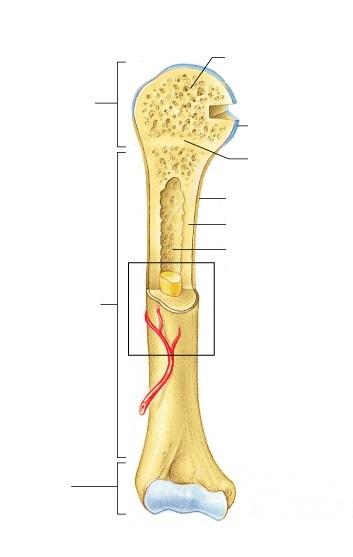 | back 18 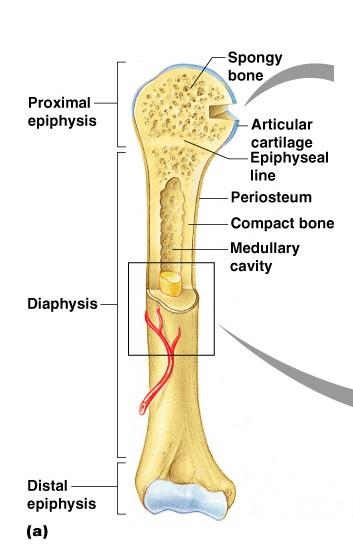 |
front 19  | back 19 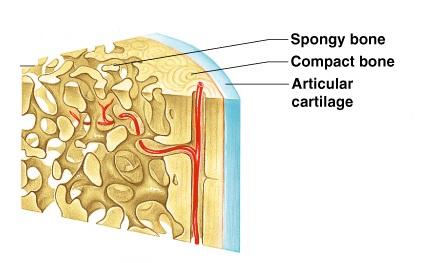 |
front 20 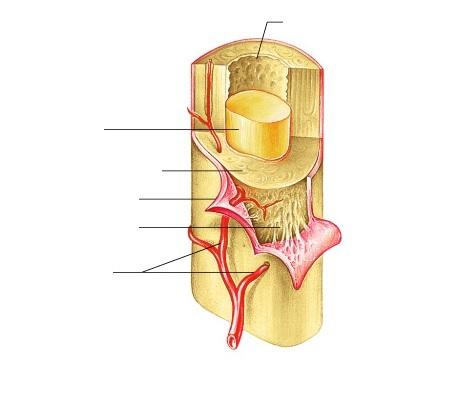 | back 20 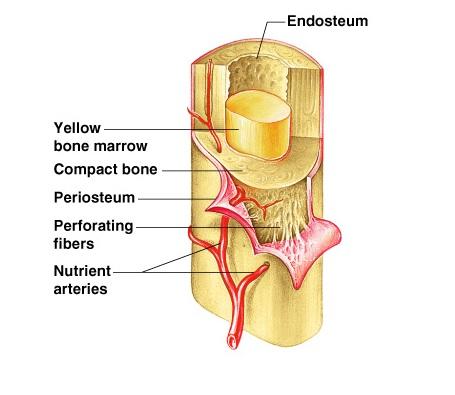 |
front 21 contains spongy bone in adults | back 21 F, epiphysis |
front 22 made of compact bone | back 22 C, diaphysis |
front 23 site of blood cell formation | back 23 J, Red Bone Marrow |
front 24 major submembranous site of osteoclasts | back 24 D, endosteum & I, periosteum |
front 25 scientific term for bone shaft | back 25 C, diaphysis |
front 26 contains fat in adult bones | back 26 G, Medullary Cavity |
front 27 growth plate remnant | back 27 E, Epiphyseal line |
front 28 major submembranous site of osteoblasts | back 28 D, endosteum & I, periosteum |
front 29 What differences between compact and spongy bone can be seen with the naked eye? | back 29 compact bone diaphysis looks solid, practically without holes or gaps-
|
front 30 What is the function of the periosteum? | back 30 The Periosteum serves as an attachment point for muscles and bones through tendons and ligaments. |
front 31 Trace the route taken by nutrients through the bone, starting with the periosteum and ending with an osteocyte in a lacuna. | back 31 The path is: Periosteum, Perforating Canals, Central Canals, Canaliculi, Lancunae, Osteocytes |
front 32 concentric lamellae | back 32 layers of bony matrix around a central canal |
front 33 lacunae | back 33 site of osteocytes |
front 34 central canal | back 34 longitudinal canal carrying blood vessels, lymphatics, nerves |
front 35 canaliculi | back 35 minute canals connecting osteocytes of an osteon |
front 36 matrix | back 36 inorganic salts deposited in organic ground substances |
front 37 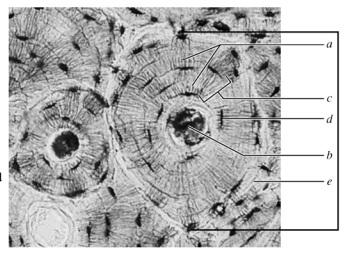 On the photomicrograph of bone on the right (365x), identify all structures maned in the key and bracket an osteon. | back 37 A. Canaliculi
|
front 38 What is the function of the organic matrix in bone? | back 38 Gives bone flexibility & strength |
front 39 Name the important organic bone components | back 39 Collagen fibers, osteocytes |
front 40 Calcium salts form the bulk of the inorganic material in bone. What is the function of the calcium salts? | back 40 Gives bone hardness & compressional strength. |
front 41 Baking removes _______________ from bone. Soaking bone in acid removes _________________. | back 41 baking removes what from bone? ORGANIC
|
front 42 Compare and contrast events occurring on the epiphyseal and diaphyseal faces of the epiphyseal plate? | back 42 The cartilage cells at the epiphyseal side are continuing to grow and divide mitotically, while the ones on the diaphyseal side are aging, dying and then osteoblasts move in to form bone. |
front 43 Type of cartilage that supports the external ear | back 43 Elastic |
front 44 Type of cartilage between the vertebrae | back 44 Fibrocartilage |
front 45 Type of cartilage that forms the walls of the voice box (larynx) | back 45 Hyaline |
front 46 Type of cartilage that forms the epiglottis | back 46 Elastic |
front 47 Type of cartilage forming the articular cartilages | back 47 Hyaline |
front 48 Type of cartilage that forms the meniscus | back 48 Fibrocartilage |
front 49 Type of cartilage that connects the ribs to the sternum | back 49 Hyaline |
front 50 Type of cartilage thats the most effective at resisting compression | back 50 Fibrocartilage |
front 51 The most springy and flexible type of cartilage | back 51 Elastic |
front 52 The most abundant type of cartilage | back 52 Hyaline |